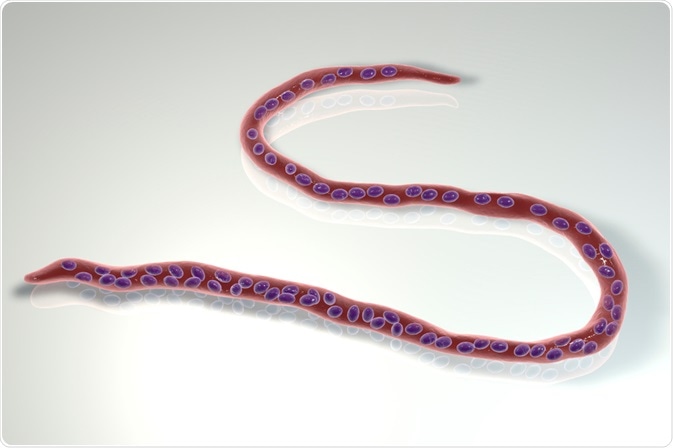Onchocerciasis, which is also known as river blindness, is an infectious condition of the skin and eyes that is caused by the parasitic worm Onchocerca volvulus. Onchocerciasis is transmitted by the bite of a blackfly (genus Simulium) that is infected with the parasite, usually in regions with a fast-flowing river or stream.
The vast majority of cases occur in African countries, although the disease does exist in other areas of the world, such as Latin America.
Treating and eliminating onchocerciasis
Onchocerca life cycle
For a human to become infected with onchocerciasis and symptoms to present, a number of steps must occur. Onchocerciasis begins with an infected blackfly (genus Simulium) biting a human host, thus introducing third-stage filarial larvae into the subcutaneous skin tissues of the human. The larvae will develop into adulthood, called filariae, and can reside in nodules in the skin for approximately 15 years.
These nodules contain both male and female filariae and can produce millions of larvae, called microfilariae, which have a lifespan of one to two years. These microfilariae can be found in connective tissues, skin, blood, urine, and sputum.

Onchocerca volvulus. Image Credit: Kateryna Kon / Shutterstuck.com
To repeat the transmission and spread of the infection to other individuals, a blackfly will need to bite a human host and ingest microfilariae. The microfilariae will then migrate from the gut to the thoracic muscles of the blackfly.
From this point, microfilariae will develop into third-stage infective filarial larvae and migrate to the proboscis of the blackfly. The infected blackfly will then repeat the cycle by biting a human host and subsequently introducing third-stage filarial larvae into the subcutaneous skin tissues of the human.
Symptoms
Individuals who have been infected with onchocerciasis do not experience symptoms initially, as the infection requires time to grow and spread. The larvae mature into adults within one year of introduction and live in nodules in the skin for approximately 15 years.
The nodules are usually found near the hips, pelvis, ribs, shoulder blades, and skull. It is these areas that are initially affected by symptoms, such as:
- Itching of skin
- Nodules under the skin
- Rough or coarse skin
- Hyperpigmentation of skin
- Eye lesions
- Vision changes
Without treatment, significant changes to the skin may be noted, including roughness, coarseness, and hyperpigmentation.
After continued severe infection, eye lesions may occur, caused by the death of larvae in the eyes. The resulting small opaque spots on the cornea can lead to the cloudiness of vision or loss of vision. As a result of this, onchocerciasis is the second leading cause of blindness due to an infectious disease, after trachoma.
Diagnosis
People infected with onchocerciasis will not show signs of the condition immediately; therefore, diagnosis is often made 3 to 15 months after the initial infection.
Localized dermatitis or subcutaneous nodules may be visible upon physical examination and a biopsy of the affected area can be analyzed for the presence of microfilariae in a laboratory.
If onchocerciasis is suspected, nodules can be removed and analyzed to identify adult worms. For mild infections, a polymerase chain reaction can be used to diagnose the infection, although this method of diagnosis is costly.
Treatment
Treatment for onchocerciasis involves the eradication of microfilariae, as the current treatments that target adult worms are toxic for humans.
Ivermectin is recommended for patients with the condition, as it is safe and effective. As this agent targets microfilariae, it reduces the reproduction of the worms and the disease does not progress.
However, treatment is required on a long-term basis, as adult female worms can continue to reproduce microfilariae, usually for 10 to 15 years. Standard treatment is once per year, although some patients require more frequent dosing.
References
Further Reading